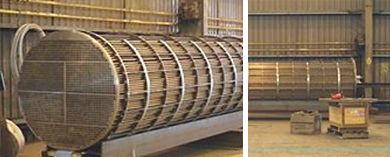
- (03) 5909 8218
- enquiry@fusionweld.com.au
How Pressure Vessels Should Be Designed For Safety and Quality
October 6, 2015

Safety concerns dominate the minds of design engineers. Products are taking shape from mathematical theories, from geometry computations and metallurgical technology, but these design-centric tasks are always tied to a safety factor. The profile of the inner chamber is part of the equation, as is the thickness of the walls and the welding technique applied to the seams. Even the selection of the alloy complements this safety factor, adding mechanical strength to the outline.
A Peak Inside the Innards of Pressure Vessels
A pressure differential exists between the inside of the container and the outside world. Inside the container, the stored substance is acting on the structure in accordance with the laws of fluid dynamics. These hazardous materials, caustic fuels and toxic chemical compounds, exert stress on the structural integrity of the vessel, and it's the job of in-built safety factors to counter these dangers. International industry standards incorporate this safety factor as a percentile rating or a multiplier, thus ensuring the vessel can withstand its designed pressure rating plus an in-built safety cushion.
Coping with Transient Forces
Even though the rated pressure of the gas or fluid is established, there are a number of other issues to consider before the container can be designed. State changes occur in some fluids, a flash from a liquid state to that of a gas. Temperature changes dictate these changes, as do the capacity of the vessel. In the case of a chemical plant, the changes become more complex. Reagents and catalysts cause energetic transitions to occur in the fluid, and there's a subsequent change in the pressure differential within the container.
Reinforcing Mechanical Integrity
Having outlined the profile of the container in terms of fluid states, pressure variations, and mathematical principles, stresses are defined and it's time for the fabrication workshop to implement the production phase, to create the shell and infuse the form with its calculated safety factor. ASME regulations and international codes outline this process in more detail, illustrating the procedure with mandated guidelines. For example, MAWP (Maximum Allowable Working Pressure) is a key variable in this scenario, one that's quoted as a maximum limit for the weakest component in the system.
Micro-crystalline tests and ultrasonic weld inspections pair with the mathematically-derived structural integrity rating of the pressure vessels to form a compelling series of products. Approved for installation, the final product is mathematically designed, mechanically fabricated, and professionally inspected to ensure it conforms to and even exceeds its peak rated operating pressure (See the AS120 codes for more details on this intriguing subject).
Contact Details
Fusion - Weld Engineering Pty Ltd
ABN 98 068 987619
1865 Frankston Flinders Road,
Hastings, VIC 3915
Ph: (03) 5909 8218
Optimized by NetwizardSEO.com.au
Recent Posts
- Compressed Hydrogen Storage Vessels: Material Selection, Design & Australian Standards
- Welding QA/QC in Oil & Gas Pressure Vessel Fabrication – Ensuring Code Compliance
- AS1210 vs ASME VIII Pressure Vessel Code: Key Differences for Australian Projects
- Mitigating Hydrogen-Induced Cracking in Pressure Vessels: Engineering and Material Strategies
- Storage Tank Solutions Australia: Field-Erected, Prefabricated & Self-Bunded Explained
- Reducing Environmental Risks: Self-Bunded Tanks in Australian Oil & Gas Operations
- Precision in Production: How Pressure Vessels Are Manufactured for Industrial Safety
- Shell & Tube Heat Exchangers: Improve Thermal Control & Energy Recovery in Petrochemical & Pharmaceutical Plants
- In-Service Inspection for Compressed Air Receivers for Power Plant Shutdown Prevention
- Power Plant Pipe Spooling Fabrication – Get Rapid, Code-Compliant Spools Ready for Installation
- Field Erected Tanks: Safe, Reliable On-Site Fuel Storage Solutions in Australia
- Custom Pressure Vessel Fabrication for Flammable Gases
Posts 2025
- Compressed Hydrogen Storage Vessels: Material Selection, Design & Australian Standards
- Welding QA/QC in Oil & Gas Pressure Vessel Fabrication – Ensuring Code Compliance
- View all articles…
Posts 2024
- Large Process Vessels: Optimising the Design for Maximum Efficiency [2025]
- Pressure Equipment Management System Installation: Detect Equipment Faults Early
- View all articles…
Posts 2023
- Pressure Piping System Inspection: A Gift of Safety for the Holidays
- Deaerator Inspections by Fusion-Weld Engineering and How They Reduce System Downtime
- View all articles…
Posts 2022
- How Fusion Weld Keeps Up With AS-NZS ISO 9001:2008 Standard
- Boiler Equipment Safety Inspection During the Summer Season
- View all articles…
Posts 2021
- Avoid These Factors and Practices that Contribute to Sealing Damage in Pressure Vessels
- Do's And Don'ts Of Industrial Boiler Inspection And Maintenance From Fusion-Weld
- View all articles…
Posts 2020
- What are the Risks and Hazards Involved in Pressure Vessel Equipment?
- How to Know if Your Pressure Equipment Needs Repair or Replacement?
- View all articles…
Posts 2019
- Factors that Contribute to Pressure Vessel Failure
- Pressure Vessel Regulations in Australia: What are the Mandatory Requirements?
- View all articles…
Posts 2018
- Pros and Cons of Spherical vs. Cylindrical Pressure Vessels
- What are the Different Hazard Levels in Pressure Vessels?
- View all articles…
Posts 2017
- Transportable Pressure Vessels: The Importance of Inspection and Safety Checks
- Fracture Mechanics and Stress Analysis of Cracks in Pressure Vessels
- View all articles…
Posts 2016
Posts 2015
- What Are Deaerators & Feedwater Vessels?
- Precautions and Safety for Compressed Air Receiver Vessels
- View all articles…
Posts 2014
- Demonstrating In-process Inspection Procedures
- Static Grounding Practices and Standards
- View all articles…